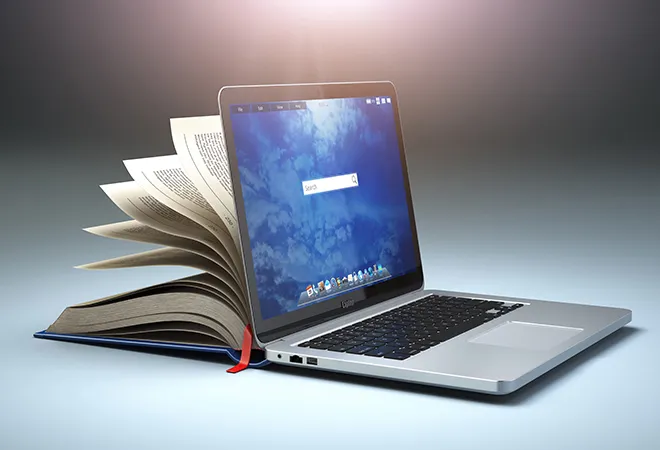
According to the Annual Status of Education Report, only 43.9% of Standard 8 students could carry out division and only 72.8% of them could read Standard 2 level literature in rural public schools.
Considering this, technology might be the most effective way to improve schools. While easy access to technology resources is critical for a digital school, it is not enough. Simply providing laptops or computers for usage has no positive outcome on learning. Therefore, it is important for technology to be integrated into the pedagogical methods as it has shown to improve average grades and learning outcomes.
One of the most popular models for integration is the Substitution-Augmentation-Modification-Redefinition (SAMR) model. The first stage is the replacement of manual practices with information and communication technologies (ICT) based ones such as usage of projectors instead of traditional chalkboards. Second stage, involves substitution but with functional improvements. This includes usage of word processors with spell checkers and using search engines. The third stage is the significant re-designing of tasks. An example would be the usage of Google Classroom as a paperless way to create, distribute and grade assignments. The last stage is the creation of new tasks that would be inconceivable without the use of ICT. These include simulations, games, open education resources and online tutoring systems.
A student-centered approach could include the use of online tutoring systems such as Mindspark, an adaptive learning programme helping students with mathematics. Such measures have been shown to improve both learning, and grades.
A computer-aided instruction programme in Gujarat replaced some time spent on the normal lessons taught at school. A 2008 study showed that this lead to lower scores, showing that simply using computers can be harmful to learning. In contrast, progammes allowing students to read grade-level content at their own pace have a moderate positive impact. Similarly, in Peru, the “One Laptop per Child” programme increased the ratio of computers to students in schools, but was shown to have no impact of test scores in maths and language subjects. On the other hand, applications that deliver personalised content depending on the student’s learning level might provide much higher outcomes. Technology, if used effectively, has the potential to greatly improve the quality of education for millions of students in the country.
One of the main issues that is encountered by this approach is the lack of technical know how. A study done by the Tata Trusts in four supplementary education centres for adolescents in four villages in Murshidabad district of West Bengal tried addressing this issue. They conducted workshops where teachers are familiarised with computer applications. They were told to create projects as if they were part of the lesson plan they had designed. Not only did this help them understand technology integration and gain confidence in carrying it out, but also made it easier for teachers in the second workshop to use the same applications as they had learned by observing the first batch of teachers at their centres.
A student-centered approach could include the use of online tutoring systems such as Mindspark, an adaptive learning programme helping students with mathematics. Such measures have been shown to improve both learning, and grades. A 2017 study by the National Bureau of Economic Research (NBER) that analysed after-school intervention for students in the 6-10 grades noticed twice the progress in mathematics, and 2.5 times the progress in Hindi compared to the students who weren’t on the intervention. There was also a 12% increase in answers given to easy questions and 36% increase on harder topics in mathematics. In Hindi, there was a 7% increase on questions answered on easy topics and 19% on the hard ones. The study also stated that weaker students benefited more from the intervention. This could be because the other students did not get personalised attention or were not exposed to innovative methods of teaching in school.
The Mindspark programme used in the study costs Rs 1000 per student, including infrastructure cost, hardware and software. The NBER study’s authors state that large scale implementation of the programme could cost as little as Rs 150/student per month, excluding rent and utilities. This is incredibly cost efficient compared to the school’s Rs 1500 monthly spending per pupil. An average class consists of students of five to six grade in terms of learning levels. It is difficult for a teacher to provide personalised attention that each student needs. This is where Mindspark and other learning programmes could potentially bridge the gap.
The Mindspark programme used in the study costs Rs 1000 per student, including infrastructure cost, hardware and software. The NBER study’s authors state that large scale implementation of the programme could cost as little as Rs 150/student per month, excluding rent and utilities. This is incredibly cost efficient compared to the school’s Rs 1500 monthly spending per pupil.
These two methods of approaching the integration of technology into our classrooms and schools are long-term solutions. These are the part of the Redefinition stage. There are also smaller steps that could have a significant impact on learning methodology. One of the best ideas is video recording of classroom lectures. These lectures are then sent to each student. There are multiple benefits to this. It is incredibly helpful for students involved in athletics, who can miss up to 30 days of school leaving them with a lot of material to cover up which can be quite difficult. The other students could also benefit as listening to audio acts as an easy way to revise concepts at home.
Talking to students, I received several ideas about what schools could do to use technology. The primary suggestion was to allow easier communication between teachers and students, to allow easy solving of doubts. This is especially crucial for students who are studying for exams. The solution used by my own school was to use a mobile application called Teno. Here, teachers could send daily assignments, notifications and important common information for their class. My school also had a portal login website that allows students to check their attendance records, discipline slips, important dates, registration forms, etc. This makes accessing student information incredibly convenient. Another popular idea was the inclusion of phones and laptops into the classroom environment. According to students, using laptops has several benefits, it allows faster note taking, allows students to record lectures for later viewing, allows students to look up concepts they did not understand, that too without disturbing the entire class.
According to a student from an international school in Mumbai, her school’s use of technology creates a more effective environment for individual learning as it provides students access to numerous educational resources and makes learning easier, faster and more enjoyable. Other private schools should also consider allowing students to use their devices in a limited manner to allow them access to educational resources. One of the most popular online resources is offered by Khan Academy which offers free courses to students in a variety of subjects such as economics, history, mathematics and physics. It also offers specialised courses for 10th and 12th Indian exams. This can be used by students to relearn concepts they didn’t understand in school or to prepare for their classes in advance.
The measures suggested above include long terms-models for integration of technology as well as immediate short-term actions that can be implemented easily. By focusing both on training teachers for effective usage of ICT as well as implementation of programmes providing personalised education to students, we can ensure significant improvements in the learning process and test scores.
The author is a research intern at ORF, Mumbai.
The views expressed above belong to the author(s). ORF research and analyses now available on Telegram! Click here to access our curated content — blogs, longforms and interviews.




 PREV
PREV


